Do you have lower back pain when playing golf? If so, you’re not alone. Many golfers experience back pain at some point during their golfing career. The good news is that there are a few simple stretches that you can do to help relieve the pain. In this blog post, we will discuss the best golf stretches for lower back pain relief. We’ll also provide step-by-step instructions on how to perform each stretch. So, if you’re looking for some relief from your lower back pain, keep reading!
Contents
- 1 What Are Golf Stretches?
- 2 Why Does My Lower Back Hurt After Golf?
- 3 How To Treat Lower Back Pain After Playing Golf?
- 4 How Should I Warm Up My Lower Back Before Golf?
- 5 What Stretches Can A Golfer Use To Relieve Back Pain?
- 6 Stretching Exercises For Golfers Over 50
- 7 How Long Will It Take To Relieve Lower Back Pain?
- 8 Conclusion
What Are Golf Stretches?
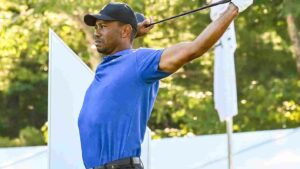 Golf stretches are exercises that help improve flexibility and range of motion in the muscles and joints used during the golf swing. They can also help to prevent injuries, such as lower back pain, by keeping your muscles and joints healthy and mobile. Without golf stretches, the muscles and joints used during the golf swing can become tight and restricted, which can lead to pain and injuries.
Golf stretches are exercises that help improve flexibility and range of motion in the muscles and joints used during the golf swing. They can also help to prevent injuries, such as lower back pain, by keeping your muscles and joints healthy and mobile. Without golf stretches, the muscles and joints used during the golf swing can become tight and restricted, which can lead to pain and injuries.
Why Does My Lower Back Hurt After Golf?

Lower back pain is a common complaint among golfers. There are many reasons why your lower back might hurt after playing golf, but the most likely are:
- Poor posture while playing: If you have poor posture while swinging the golf club, it can put extra strain on your lower back.
- Twisting/turning too much: Golf is a rotational sport, which means you’re constantly twisting and turning your torso. This can lead to lower back pain if you don’t warm up properly or if you have weak abdominal muscles.
- Hitting the ground too hard: If you hit the ground too hard with your golf club, it can jar your lower back and cause pain.
- Wearing shoes that don’t fit well: Ill-fitting golf shoes can also contribute to lower back pain.
How To Treat Lower Back Pain After Playing Golf?
If you have lower back pain after playing golf, there are a few things you can do to help relieve the pain.
1. Use a heating pad or ice pack: Applying heat or ice to your lower back can help reduce inflammation and pain.
2. Take over-the-counter pain medication: If your lower back pain is mild, you can take over-the-counter pain medication such as ibuprofen or acetaminophen.
3. Do some gentle stretches: Stretching your hamstrings, glutes, and lower back muscles can also help reduce pain.
4. See a doctor or physical therapist: If your lower back pain is severe or doesn’t improve with home treatment, you should see a doctor or physical therapist. They can help you find the underlying cause of your pain and develop a treatment plan.
How Should I Warm Up My Lower Back Before Golf?
Most people don’t realize that the lower back is actually very fragile. It’s made up of a lot of small bones and joints that can easily be injured. That’s why it’s so important to warm up your lower back before golf.
One of the best ways to warm up your lower back is by doing some simple stretching exercises and gentle movements. You can also use a heating pad or warm towel to help loosen up your lower back muscles.
Warming up the lower back before golf is important as it helps prevent injuries. It also allows the muscles to work more efficiently and makes golfing more enjoyable.
What Stretches Can A Golfer Use To Relieve Back Pain?
There are a few different stretches that can help alleviate back pain for golfers. Let us discuss a few of them now.
The Seated Twist

This stretch is great for targeting lower back pain specifically. To do it, simply sit on the ground with your legs out in front of you and your spine straight. Then, place your right hand on your left knee and twist your torso to the left, looking over your left shoulder. Hold this position for 30 seconds, then repeat on the other side.
The Child’s Pose
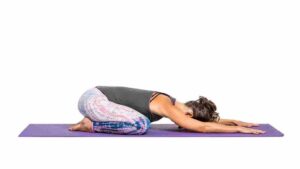
This is a great all-around stretch for the back and spine. To do it, start on your hands and knees with your spine neutral. Then, sit back on your heels and reach your arms out in front of you, resting your forehead on the ground. Hold this position for 30 seconds to 1 minute.
The Cat-Cow Pose

This is another good all-around stretch for the back. To do it, start on your hands and knees with your spine neutral. Then, arch your back up towards the ceiling like a scared cat, hold for a few seconds, and then round your back down towards the ground like a cow. Repeat this movement for 10-20 repetitions.
The Cobra Pose
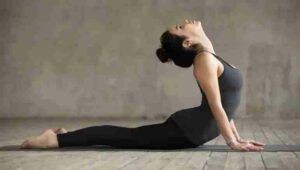
This stretch is good for targeting pain in the upper back. To do it, lie on your stomach with your legs out straight behind you and your palms flat on the ground next to your chest. Then, press your palms into the ground and lift your chest and head off the ground, holding for a few seconds. Repeat 10-20 times.
The Doorway Stretch

This stretch is good for targeting pain in the middle back. To do it, stand in a doorway with your arms outstretched to either side at shoulder level, forming a “T” shape. Then, lean forward until you feel a stretch in your back. Hold for 30 seconds to 1 minute.
These are just a few stretches that can help alleviate back pain for golfers. If you are experiencing back pain, be sure to talk to your doctor or physical therapist to find out which stretches will be most helpful for you.
Stretching Exercises For Golfers Over 50
As we age, it’s important to keep our bodies healthy and active. That’s why stretching exercises are so important, especially for golfers over 50. Stretching can help prevent injuries, increase the range of motion, and improve flexibility.
Here are some minimum stretches that can help relieve lower back pain:
Hamstring stretch
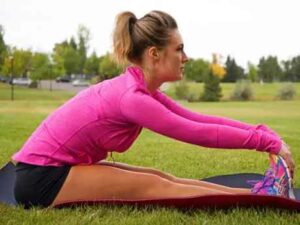
Sit on the ground with your legs straight out in front of you. Reach for your toes, and hold the stretch for 30 seconds.
Piriformis stretch
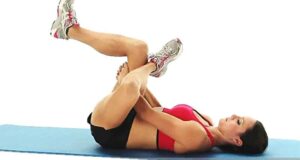
Lie on your back with your knees bent and feet flat on the ground. Place a hand on your right knee and pull it toward your chest. Hold the stretch for 30 seconds, and then repeat on the other side.
Quadriceps stretch
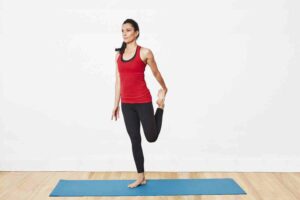
Stand up straight and hold on to a chair or wall for balance. Bend your right knee and bring your heel toward your buttock. Hold the stretch for 30 seconds, and then repeat on the other side.
Lower back stretch
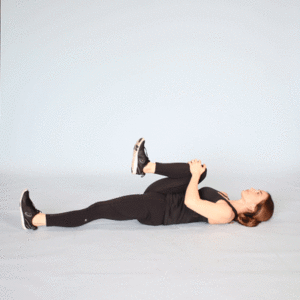
Lie on your back with both knees bent and feet flat on the ground. Place your right hand on your left knee and pull it toward your chest. Hold the stretch for 30 seconds, and then repeat on the other side.
Remember to warm up before stretching, and to breathe deeply throughout each stretch. Hold each stretch for 30 seconds and repeat 2-3 times. With regular stretching, you’ll soon notice an improvement in your flexibility and range of motion.
How Long Will It Take To Relieve Lower Back Pain?
The type of golf stretches and the number of repetitions performed will determine how long it takes to see lower back pain relief. For instance, if a golfer is stretching their hamstrings with the goal of improving their swing, they might perform 3 sets of 10 repetitions. However, if a golfer is trying to relieve lower back pain, they might perform 1-2 sets of 8-12 repetitions.
Physical therapy is also helpful in such cases. It can help improve the range of motion and flexibility in the lower back. One study found that golfers who performed a specific set of exercises targeting the lower back saw significant reductions in pain and disability compared to those who didn’t exercise. The golfers who exercised also had better quality of life scores.
Conclusion
In conclusion, golf stretches for lower back pain relief can be very helpful. It is always important to warm up and stretch before playing any sport, especially golf. Golf is a low-impact sport, but the repetitive nature of the swing can lead to lower back pain. By stretching the muscles in your back, hips, and legs, you can help prevent or alleviate lower back pain. But if the pain exceeds it’s better to consult a doctor for physical therapy or other treatments.
Physical Therapy help patients recover from pain. If you’re experiencing Back pain, Shoulder pain, Knee pain, Neck pain, Elbow pain, Hip pain, or Arthritis pain, a physical therapist at MantraCare can help: Book a physiotherapy session.


